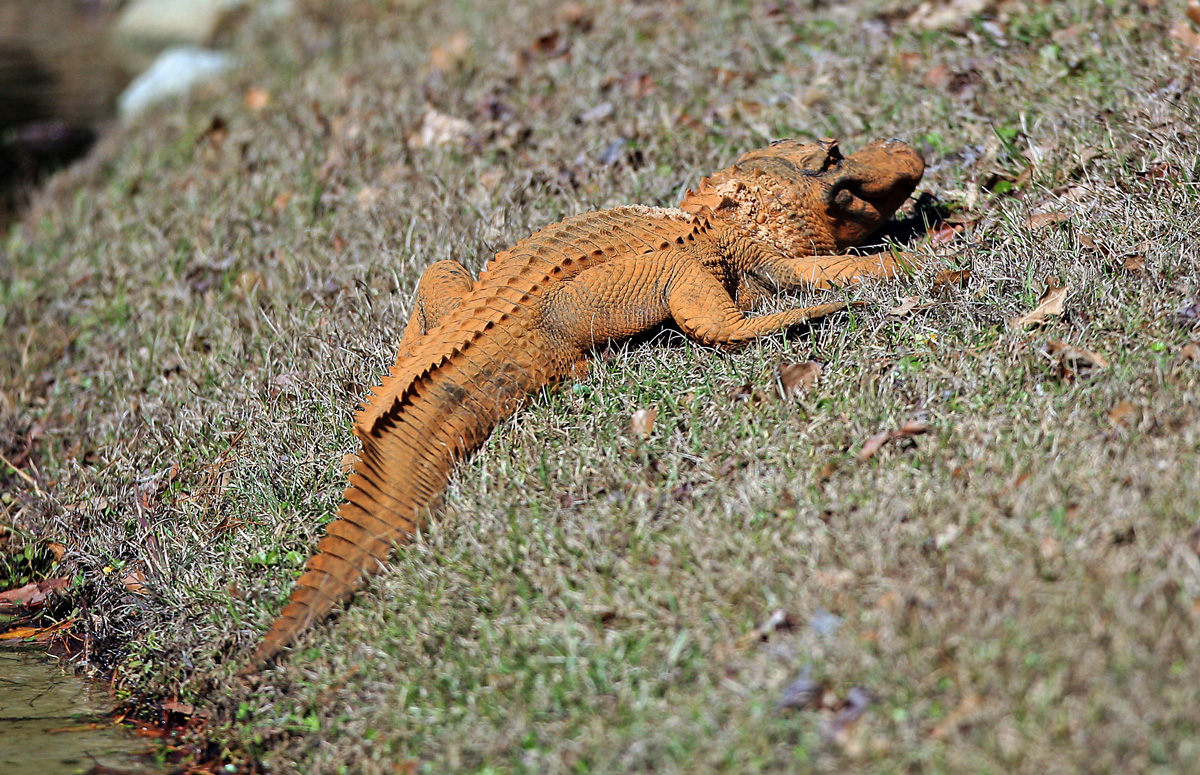Orange-Hued Alligator Spotted in South Carolina

A predatory beast with leathery orange skin is gallivanting through social media, sowing fear in its wake.
That's because there have been recent sightings of a tangerine-colored alligator in South Carolina.
Earlier this week, members of a residential community in Hanahan, South Carolina, spotted an unusual sight near one of the retention ponds — an alligator with skin tinted an orange hue. Estimated to be 4 to 5 feet (1.2 to 1.5 meters) long, the apricot alligator was nicknamed "Trumpigator" by its human neighbors, local television newscast WCBD News 2 reported. [Alligator Alley: Pictures of Monster Reptiles]
The carrot-colored crocodilian is most likely an American alligator (Alligator mississippiensis) — the only crocodilian native to South Carolina — which can live to be more than 60 years old and reach lengths of up to 13 feet (4 m), according to the South Carolina Department of Natural Resources (SCDNR).
Earlier this week, the gator was photographed basking on the bank near a pond, its bright orange skin standing out in sharp contrast to the patchy brown grass. Several Facebook commenters joked that the alligator must be a fan of the Tigers football team at Clemson University, South Carolina, which has an orange logo and uniforms.
But alligators don't paint themselves in pumpkin palettes to show sports allegiances or to look tanned for television cameras. So what might have turned this alligator the unexpected hue? One explanation might be rust, iron oxide, from a steel culvert where the alligator was hiding out during the winter, an SCDNR representative tweeted.
An environmental factor like algae or a pollutant in the water could also color a gator's skin, but it's difficult to know for sure, Josh Zalabak, a herpetologist with the South Carolina Aquarium, told WCBD News 2. If the discoloration is only skin-deep, it should disappear in a few weeks, when the alligator sheds its skin, WCBD News 2 reported.
Sign up for the Live Science daily newsletter now
Get the world’s most fascinating discoveries delivered straight to your inbox.
While rusty reptiles are rare, this isn't the first time someone has spied an alligator resembling an escapee from a Cheetos factory.
In 2011, news of an orange alligator photographed in Venice, Florida, prompted speculation about whether the beast's appearance represented a dramatic dye job or "evolution in action," biologist David Steen wrote in a blog post that year.
Steen, an assistant research professor at the Auburn University Museum of Natural History in Alabama, noted that the Florida Fish and Wildlife Conservation Commission weighed in quickly to explain that the peculiar color was probably caused by something in the water. In fact, Steen had observed this phenomenon firsthand, in turtles he captured years earlier in New York State, he said.
"I would occasionally visit ponds with water stained from naturally occurring sediment. As you might expect, the turtles I caught in these ponds were colored differently from those I caught elsewhere," Steen wrote.
As tempting as it might be to venture closer to a strangely colored gator to snap a photo, wildlife officials warn that people need to exercise caution around these large predators, and maintain a safe distance. About 60 feet (18 m) is recommended by the Savannah River Ecology Lab (SREL) at the University of Georgia, in a post about alligator safety.
"Please remember that they are wild animals and should be respected as such," J. Whitfield Gibbons, director of outreach for SREL, said in the statement. "A few precautions on our part can help both humans and alligators coexist safely."
Original article on Live Science.

Mindy Weisberger is an editor at Scholastic and a former Live Science channel editor and senior writer. She has reported on general science, covering climate change, paleontology, biology and space. Mindy studied film at Columbia University; prior to Live Science she produced, wrote and directed media for the American Museum of Natural History in New York City. Her videos about dinosaurs, astrophysics, biodiversity and evolution appear in museums and science centers worldwide, earning awards such as the CINE Golden Eagle and the Communicator Award of Excellence. Her writing has also appeared in Scientific American, The Washington Post and How It Works Magazine. Her book "Rise of the Zombie Bugs: The Surprising Science of Parasitic Mind Control" will be published in spring 2025 by Johns Hopkins University Press.










